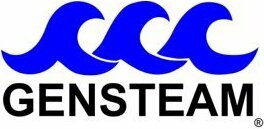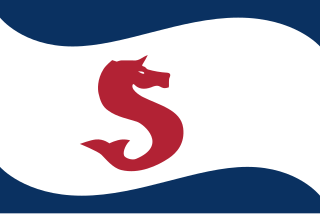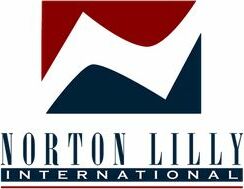
The Isthmian Steamship Company was a shipping company founded by US Steel in 1910.
Mississippi Shipping Company of New Orleans, Louisiana was a passenger and cargo steamship company founded in 1919. In 1961 officially changed its name to the Delta Line. The Mississippi Shipping Co. serviced port from the Gulf of Mexico and east coast of South America. The Mississippi Shipping Co. was formed to support coffee merchants and Brazilian produce to New Orleans and up the Mississippi River. competing with the New York City trade. Delta Line failed to upgrade to container ships and modernize as other shipping lines did in the 1970s. In 1982, Delta Line, now owned by the Holiday Inn Corporation sold the line to Crowley Maritime. Crowley was the largest US barge and tugboat operator at the time. Crowley started to modernize the ships on the route, but sold the shipping line to the United States Lines in 1985. United States Lines brought some of the ships into its routes but went bankrupt in 1986. At its peak in 1949, the Mississippi-Delta line owned 14 ships with a total of 98,000 gross register tonnage. Delta Line also moved into passenger cruise with to ship. During World War II the Mississippi Shipping Company was active with charter shipping with the Maritime Commission and War Shipping Administration. During wartime, the Mississippi Shipping Company operated Victory ships, Liberty ships, and a few Empire ships.
Pacific Far East Line, also called PFEL in short, was a passenger and cargo shipping line founded in 1943 by Thomas E. Cuffe, in San Francisco, California. At the beginning he started by chartering foreign ships to run the lines in tramp trade. Later scheduled cargo services were added to the line. During World War II the South Atlantic steamship line was active with charter shipping with the Maritime Commission and War Shipping Administration.

General Steamship Company was founded in 1920 in Houston, Texas, United States, as a Private Company, and now goes by Gensteam since 1996. General Steamship Company has a fleet of cargo ships that operate worldwide. Gensteam has a Gensteam Operations Desk website that tracks all shipping logistics. Gensteam headquarters is now in San Francisco, California. General Steamship Company was part owner of American Pacific Steamship Company in New York state and Los Angeles during and post World War II. American Pacific Steamship Company was founded in 1942 in New York City, and was previously called Los Angeles Tanker Operators Inc. which operated T2 tanker ships. During World War II the General Steamship Company and American Pacific Steamship Company were active with charter shipping with the Maritime Commission and War Shipping Administration.

Black Diamond Steamship Company (BDSC) operated passenger and cargo liners from New York City to Rotterdam and Antwerp. It was founded by J.E. Dockendorff in 1919, and named the American Diamond Line by the United States Shipping Board. The company was profitable in the 1920s and early 1930s. Prior to the United States' entry into World War II, the nation's neutrality policy ended much of the lines trade. Dockendorff stepped down as a principal executive in 1934, selling the only one of the company's 21 ships not owned by the government: New Britain, which he had bought in 1918. During World War II the company sold most of its American Diamond Line ships and moved to charter shipping with the Maritime Commission and War Shipping Administration. During the war, the Black Diamond Steamship Company operated Victory ships and Liberty ships. These ships were operated by their own crews; the US Navy supplied United States Navy Armed Guards to man the deck guns and radio. The most common armament mounted on these merchant ships were the MK II 20mm Oerlikon autocannon and the 3"/50, 4"/50, and 5"/38 deck guns. After the war there were many surplus ships and much competition. Black Diamond Steamship Company continued to operate after the war, but finally closed in 1955.
Weyerhaeuser Steamship Company was a cargo Liner company founded in Tacoma, Washington. Weyerhaeuser Steamship Company was founded by Weyerhaeuser Company in 1933. Weyerhaeuser is one of the largest lumber and paper companies in the United States. First called the Weyerhaeuser Timber Company which started with ships for towing logs in the Northwestern United States. Weyerhaeuser started Weyerhaeuser Timber Company with a ship he acquired in 1892. The log towing ship was a 140-foot sternwheeler built for the partnership, Weyerhaeuser and Denkman Company. In 1923 Weyerhaeuser added to ocean lumber cargo ship the SS Pomona and the SS Hanley. The two ships took lumber to the East Coast. In 1933 F. Weyerhaeuser starts the Weyerhaeuser Steamship Company and moves the headquarters to Newark, New Jersey. At the outbreak of World War II the US government orders the four Weyerhaeuser to take supplies to the British army in Egypt. The next year the other four company's ships are requisitioned by the War Shipping Administration. During World War II the Weyerhaeuser Steamship Company was active in charter shipping with the Maritime Commission and War Shipping Administration. During wartime, the Weyerhaeuser Steamship Company operated Victory ships and Liberty ships. The ship was run by its crew and the US Navy supplied United States Navy Armed Guards to man the deck guns and radio. The most common armament mounted on these merchant ships were the MK II 20mm Oerlikon autocannon and the 3"/50, 4"/50, and 5"/38 deck guns. In 1942 the SS Potlatch and the SS Heffron were sunk by German U-boats torpedoes. After the war, Weyerhaeuser Steamship Company purchased four Liberty ships for intercoastal shipping service. In 1950 Weyerhaeuser Steamship Company purchases the Pacific Coast Direct Line and moves its headquarter from Newark to San Francisco. In 1962 the Weyerhaeuser Line is started and Weyerhaeuser Steamship becomes a division of Weyerhaeuser Company.
Shepard Steamship Company of Boston, Massachusetts was founded in 1930 by Otis N Shepard, and H B, Shepard with service from Pacific Coast to Philadelphia, New York City, Albany and Boston. Service was called the Shepard Line Shepard Steamship Company moved to 21 West Street, New York City in 1947. The Shepard Steamship Company's main cargo was lumber products. Otis N Shepard company, Otis Shepard & Co. partnered with George H. Morse in 1868 to form Shepard & Morse Lumber Company of Burlington, Vermont. During World War II the Shepard Steamship Company was active in charter shipping with the Maritime Commission and War Shipping Administration. During wartime, the Shepard Steamship Company operated Victory ships and Liberty ships. The ship was run by its crew and the US Navy supplied United States Navy Armed Guards to man the deck guns and radio. The most common armament mounted on these merchant ships were the MK II 20mm Oerlikon autocannon and the 3"/50, 4"/50, and 5"/38 deck guns.

Interocean Shipping Company, Interocean Steamship Company of San Francisco was a subsidiary of the Bethlehem Steel Company founded in the late 1930s and closed in 1986.

A. H. Bull Steamship Company was a shipping company and passenger liner service founded in New York City in 1902 by Archibald H. Bull (1848-1920). Service started with shipping between New York and Florida. His fleet of ships then added service to other Eastcoast ports. The company is also often called the Bull Lines and the Bull Steamship Line or A. H. Bull & Company. While founded in New York, Bull soon move its headquarter to Peir 5 in Baltimore, Maryland. Bull Lines main Eastcoast ports were: Baltimore, Charleston, Philadelphia, Tampa and Norfolk, Virginia. Oversea ports: Porto Rico, Antwerp, Bordeaux, Hamburg, Bremen, Copenhagen, and West Africa. Bull Steamship Line supported the US war effort for both World War I and World War II, including the loss of ships.

States Steamship Company, also called States Line and SSS, was started in 1928 by Charles Dant, in Portland, Oregon and later moved to the headquarters to San Francisco. Dant started the States Steamship Company to take his lumber product to market. He had a fleet of lumber schooners. Dant started by leasing ships from the United States Shipping Board - Emergency Fleet Corporation and founded the Columbia Pacific Steamship Company in 1919, Columbia Pacific Steamship Company routes were between Portland, Far East and Europe. In 1928 Dant merged the Columbia Pacific Steamship Company into the States Steamship Company. The Europe route ended in 1932 and the ship moved to a Philippines route. With the shift to container shipping in the 1960s and Dant's fleet of ships becoming older and obsolete, the company into bankruptcy in 1979. States Line operated four subsidies: Pacific-Atlantic Steamship Company, California Eastern Line founded in 1937 for lumber shipping, Oregon Oriental Line and the Quaker Line.

Mystic Steamship Company, also known as Boston Tow Boat Company was a Boston, Massachusetts shipping company named after the Mystic River. The company was founded in 1854 as the T-Wharf Towing Company. Boston Tow Boat Company was an operator of ship salvaging, icebreaker shipping, and a tugboat operator. The other major operation was transporting coal. Mystic Steamship Company operated collier ships and coal barges. Coal was load at Newport News, Virginia and delivery to New York Harbor, Philadelphia and Baltimore. Mystic Steamship Company was also a bulk grain transporter. Eastern Gas & Fuel Associates, which is now Eastern Enterprises, purchased and ran Mystic Steamship Company. T-Wharf Towing Company merged into the Boston Gas Eastern Enterprises Incorporated, its parent company, on June 30, 1917. Boston Gas Eastern Enterprises reformed the shipping lines as the Boston Towboat Company Incorporated. Boston Fuel Transportation Company purchased Boston Towboat Company in 1985. Boston Fuel renamed the company the Boston Towing and Transportation Companies. In 1940, the company became the Mystic Steamship, a Division of Eastern Gas and Fuel Associates.

Merchants and Miners Transportation Company, often called M&M and Queen of Sea, was a major cargo and passenger shipping company founded in 1852 in Baltimore, Maryland. In 1852 is started with routes from Baltimore and Boston two wooden side wheelers ships. In 1859 M&M added two iron hulled steamers to its fleet. In 1866, post Civil War, M&M added routes to Providence, Rhode Island, Norfolk and Savannah, Georgia. In 1876 M&M purchased the Baltimore & Savannah Steamship Company add routes to Savannah, Jacksonville and Charleston. In 1907 the Winsor Line of Philadelphia's J. S. Winslow & Company of Portland, Maine was purchased, with seven steamships. The Winsor Line was founded in 1884 by J. S. Winslow. The Winsor Line first route was from Norfolk, Virginia to New England ports, supplying West Virginia coal. The Winsor Line sailing ship Addie M. Lawrence took ammunition to Europe during World War I. By World War II M&M had a fleet of 18 ships and add routes to Miami. With the outbreak of World War II the War Shipping Administration requisitioned Merchants and Miners Transportation Company fleet of ships for the war effort.
Boland and Cornelius Company was a shipping company founded in 1904 by Messrs Boland and Adam E. Cornelius in Buffalo, New York. Adam Edwards Cornelius came up with the idea of having self-unloading ships to save time and money. Adam Edwards Cornelius self-unloading ships changed the way ships were unloading. In 1907 Boland and Cornelius founded the American Steamship Company a subsidiary of Boland and Cornelius Company. American Steamship Company later became the current GATX Corporation. Boland and Cornelius Company flew a white and red flag with B&C in blue.

Norton Lilly International, was founded as Norton Lilly & Company in 1841 in New York City by John Norton Jr., In 1834, John Norton, Jr. moved to New York in 1834, he was born in Eastport, Maine in 1816. John Norton, Jr. John Norton, Jr. shipping experience started in 1840 when he became a partner in Russell & Norton, a shipping agency for with routes from Florida to the West India. The ship operated out of Apalachicola, Florida and in 1851 added an Australia route to the line. In 1854 John Norton Jr., and his son, Edward N. Norton, opened his own shipping agency, Norton & Company and became the manager of the sailing ship Sea Flower , which operated out of Pensacola, Florida. Norton and son expanded and added a South America route with packet sailing ships. John Norton Jr. second son Augustus Norton joined the firm in 1878. Augustus Norton died on October 17, 1889, and a year later John Norton Jr. died on October 30, 1890. Edward N. Norton continued to run Russell & Norton, but in 1907, add a partner Joseph Thomas Lilly. With the new partnership, the firm was renamed Norton Lilly & Company.
Parry Navigation Company was a shipping company founded in 1942 by Alfred Walter Parry Jr. in New York City. Alfred Walter Parry Jr. first career was ship broker with Smith & Terry Inc. in New York City. He was also the office manager of the Interocean Steamship Company of New York in New Orleans. Smith & Terry Inc also were managing agents for the some United States Shipping Board ships. Alfred Walter Parry Jr. father, Alfred Walter Parry, Sr., was an agent for a railroad company. Parry Navigation Company operated ships for the World War II. Alfred Walter Parry Jr. became a Colonel in the United States Army. Parry served with the US Army Transportation Corps in the South Pacific Ocean. Parry Navigation Company expanded the company and opened an office in San Francisco in 1945. Parry Navigation Company stated the Parry Line in 1947 and expanded with route to Galveston, Texas. The Parry Line had routes from the West Coast of the United States to Manila, Shanghai, Hong Kong and North China. Parry was the vice president for the Lykes Brothers Steamship Company for a few years. Parry was awarded the Legion of Merit and World War II Victory Medal for his service in the US Army Transportation Corps. Charles W. Perkes was a manager in Parry Navigation Company. Perkes, before Parry worked for the Dollar Line.
United States Navigation Company was founded by Edward Carl Wilhelm Oelsner (1888-1973) in New York City in 1917. Oelsner was a Prussian-born German, who came to America in 1908. In 1915 became a manager of the Hamburg America Line's New York office. In 1917 he became a steamship broker, he then founded his own steamship brokerage firm, United States Navigation Company. United States Navigation Company's first clients were the Hamburg-American Line and North German Lloyd Line. Next Oelsner entered into a joint venture with Biehl & Company chartering ships that serviced the Gulf of Mexico ports. United States Navigation Company when went from just a shipbroker to a ship owner, with the purchase of 1885 SS City of Salisbury, a 397-ton cargo ship. On March 7, 1973, Oelsner died, he and his wife, Eva, were on vacation in Torremolinos, Spain. United States Navigation Company continued doing business. In 1979 the United States Navigation Company was sold and in 1981 closed. The United States Navigation Company supported the World War II effort with its ship and as an operator of United States owned ships.
West India Steamship Company was a passenger and cargo steamship company founded in New York City in 1910. West India Steamship Company was founded by Edward R. Bacon, Robert Bacon and Daniel Bacon. Edward R. Bacon was an attorney and Daniel Bacon was a ship broker. Before founding West India Steamship Company all three had worked for the Barnes Steamship Company. They operated the West India Steamship Line. By 1913, West India Steamship Company had cargo routes from New York City and Norfolk, Virginia to Cuba, Mexico, Colón, Panama, and the Windward Islands. By 1921 West India Steamship Company added routes from Mobile, Alabama, to a number of West Indies ports. West India Steamship Company was active in supporting the World War II efforts.
Overlakes Freight Corporation was shipping agent company founded in New York City on April 21, 1932, by William M. Nicholson. Overlakes Freight Corporation operated Liberty Ships during and for post World War II efforts. Most of Overlakes Freight Corporation ships were purchased by the War Shipping Administration for the war. Nicholson also owned the Nicholson Universal Steamship Company, Nicholson, Erie, Dover, Ferry Line, Nicholson Terminal & Dock Company, Aqua Terminal & Dock Corporation and the Nicholson Transit Company.
Prudential Steamship Corporation was a shipping company founded in 1933 in New York City by Stephan Stephanidis. Prudential Steamship Corporation operated the Prudential Lines. Prudential Lines main routes was from the United States to Mediterranean ports. The Prudential Lines was never successful and was always near bankruptcy. Prudential Lines was active in supporting the World War II efforts. At its peak in the 1960s Prudential Lines owned and operated two tankers, and five cargo ships. In 1960 the Prudential Steamship Corporation was sold to Spyros Skouras and his family. In 1969 the Prudential Lines merged with Grace Lines, which continued to operate the fleet as the Prudential Grace Line.
Sword Line Inc. was a steamship company founded by Charilaos "Charles" G. Poulacos and Abbott Abercrombie in New York City in 1933. Sword Line Inc. had shipping routes from Atlantic ports to and Gulf of Mexico ports. Charilaos "Charles" G. Poulacos and Abbott Abercrombie purchased the ship Eastern Sword in 1932. The Eastern Sword was a 3,785-ton cargo ship built in 1920 at the Uraga Dry Dock Co. Ltd, at Uraga, Japan. The ship sank after being hit by a torpedo from German submarine U-162 on May 4, 1942 twelve miles (19 km) off the coast of Georgetown, Guyana. The Eastern Sword had a crew of 38 and only 13 survived the attack. Sword Line Inc. was active in supporting the World War II effort.









